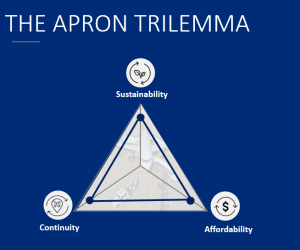Lower-carbon mobility is a necessity for the planet and will help ensure that future generations can also discover the joys of travel, as we do today. Yet despite what some may say, sustainable and greener travel should not equate to a long-term decline in air travel.
In our globalised world, the democratisation of mobility has opened the doors for many millions of new travellers. As such, air travel is irreplaceable in reach and speed and is definitely here to stay. Just how bright and sustainable the air travel future will be, is in our hands.
The question often asked is if we will hit the 2050 net zero carbon emissions target on time. While important, this target is only one milestone in the ESG picture. I’m focused on the ‘how,’ not so much the ‘if and when’… but which solutions will come together and result in net zero carbon emissions.
Looking at the economic challenges and varying levels of commitment across countries and other industry groups, business as usual is not going to cut it. To succeed and thrive, the mobility industry needs a healthy dose of collective disruption, at all levels; fuelled by an ambitious attitude to imagine what green, sustainable mobility could look like in ten, twenty, or forty years. The ESG challenge is too big to take on in one go, and has to be broken into digestible, inter-connected chunks.
To succeed and thrive, the mobility industry needs a healthy dose of collective disruption.
An approach where each industry sector, stakeholder or business does their own thing will not be enough to go above incremental ESG change to an integrated, scalable and economically viable mobility future. An ‘I’ mind-set limits scope and reach… but a ‘WE’ mind-set allows for wider perspectives, and more creativity. The ‘I’ is often limited to choices of doing this ‘OR’ that, while the ‘WE’ has more collective resources and synergies to enable doing this ‘AND’ that.
Daring to create a new mobility future
The wider question is how ‘WE’ as an industry and a society can amplify our dreams and solutions; not just how ‘I’ as a business am going to survive or make it to the next target. So the first and most important disruption has to be human: that of our own mind-sets; followed closely by disruption in when and how we collaborate.
At a more strategic level, ‘WE’ should take a step back to look at the overall mobility issues (of people and goods). A shared, forward-looking vision and increased collaboration between all stakeholders such as airlines, road and rail transport, citizen groups, travel agencies, regulators etc. would result in even more environmental and sustainability innovation and gains. But these gains are possible only if we can open our minds to alternative futures and fold our ‘I’s’ into a ‘WE’.
For example, in much of Europe, there are good regional fast rail or bus services, which could replace some carbon-heavy flight routes. As part of the Green Deal, the EU has also earmarked investment for “a fully operational, multi-modal Trans-European Transport Network” by 2050. If ‘WE’ examine the above scenario in relation to airport, airline and national environmental commitments, it could convert to reductions in CO2 emissions. But it would also mean challenging shifts in business and operational models for many stakeholders, which need to be coordinated and agreed by the ‘WE’ as part of a new collective mobility model.
Building a sustainable aviation industry, step-by-step
Disruption in mind-sets and collaboration is just as important at operational levels, such as airports, where the carbon footprint and sustainability of each airport offers many opportunities for improvement and innovation.
Within airport ecosystems, there is typically a mix of public-private stakeholders, each with specific financial and performance objectives. In the ‘I’ model, each stakeholder tries to carve out profit, anticipate future demands and influence their own corner of the regulatory landscape. Each has specific greening targets, such as lower fuel emissions, energy efficient terminals, national CO2 emissions targets... To meet targets and preserve margins, there is a kind of fence around each group’s business and staff, with each unilaterally providing ‘services’ to another stakeholder.
Here again, mind-sets need to evolve from ‘I to WE’. For airport management and at the very least for airport GSE, I strongly believe the ‘service’ model is outdated and should evolve to a ‘partnership or WE’ model, to:
- enable the co-creation of integrated solutions to meet the needs of multiple stakeholders
- enhance affordability with the aim of doing more, or better, with less
- allow sharing and/or ‘trading’ of sustainability targets and gains and between stakeholders
- guarantee operational continuity across the airport
An example is GSE pooling, where a fleet is shared by multiple airlines. Traditionally, each airline has a contract to rent a fixed number of dedicated equipment from the GSE provider, to be used by the handling services. When not in use, the equipment mostly sits idle on an already overcrowded apron, not necessarily in the best spot for its next use. In this ‘service’ model, it is estimated each airline has an average of 20% more equipment than is regularly used.
 Taking the lead as an integrator and identifying issues based on a framework known as the Apron Trilemma (Sustainability, Continuity, Affordability), the pooling solution was developed; which moved the relationships and operations from an ‘I or service’ model to a ‘WE or partnership’ model.
Taking the lead as an integrator and identifying issues based on a framework known as the Apron Trilemma (Sustainability, Continuity, Affordability), the pooling solution was developed; which moved the relationships and operations from an ‘I or service’ model to a ‘WE or partnership’ model.
It enables faster transition to a sustainable fleet as capital investments are shared by the ‘WE’ rather by each separate ‘I’; and infrastructure needs are determined for the ‘WE,’ with a longer-term vision. In addition to the positive CO2 impact, there is a rationalisation of operating costs, and a reduction in congestion on the apron with kick-on improvements in safety, noise pollution and gains in punctuality. Supported by the roll out of telematics, GSE pooling has benefited all stakeholders.
I will close by saying that the greatest threat to our industry is the belief that someone else will save it. I am strongly convinced that the best way to predict the future is to create it; and that collectively, we have what it takes. ‘I’ therefore invite you to join the ‘WE’ on this exciting journey to imagine and build a more sustainable aviation future.
TCR were Sustainability Sponsors of GAD World 2021, find out more here >>
 Kristof Philips is TCR Group's Chief Operating Officer, since the beginning of 2020. During its former position as Managing Director of TCR UK, Kristof achieved a substantial transformation of the Groups' British subsidiary, resulting in a tangible positive impact on local people and processes. Besides its experience in the aviation industry, be these Airports, Airlines or independent ground handlers, Kristof has a solid background in M&A, business consultancy, projects' transformation and JV management. His out-of-the-box, passionate and innovative management approach is fully dedicated to consolidating TCR's pivotal role as Integrator for sustainable and long-lasting apron solutions, in a fast-changing industry.
Kristof Philips is TCR Group's Chief Operating Officer, since the beginning of 2020. During its former position as Managing Director of TCR UK, Kristof achieved a substantial transformation of the Groups' British subsidiary, resulting in a tangible positive impact on local people and processes. Besides its experience in the aviation industry, be these Airports, Airlines or independent ground handlers, Kristof has a solid background in M&A, business consultancy, projects' transformation and JV management. His out-of-the-box, passionate and innovative management approach is fully dedicated to consolidating TCR's pivotal role as Integrator for sustainable and long-lasting apron solutions, in a fast-changing industry.
